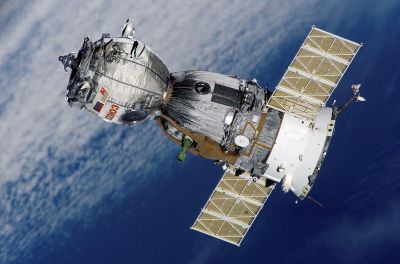Reliable energy pushes space frontiers

Soyuz TMA-7 spacecraft
By The original uploader was Thegreenj at English Wikipedia (Transferred from en.wikipedia to Commons.) [Public domain], via Wikimedia Commons
Spacecraft carry tremendous amounts of instrumentation that require electricity. Scientists are developing a novel form of nuclear energy for heat-to-electricity conversion with no moving parts.
Maintaining power in space exploration vehicles in deep space is
critical to mission success. Solar power is minimal there, particularly
in Jupiter's orbit and beyond. Even around Mars, night-time and dust
storms impede a stable energy supply.
Radioisotope power systems (RPSs) are a type of nuclear energy technology that uses heat to produce electricity for spacecraft and their scientific instruments. The heat is produced by the natural radioactive decay of plutonium-238. RPSs have been fuelling missions of the National Aeronautics and Space Administration (NASA) for more than 50 years. The EU-funded project 'Space thermoacoustic radio-isotopic power system' (SPACE TRIPS) was initiated to provide competitive European RPS technology.
The focus is on increasing the technology-readiness level of promising coupled thermoacoustic (TAc) and magnetohydrodynamic (MHD) electricity generation. In contrast to conventional Stirling cycle technology with pistons under development in the United States, TAc–MHD generation has no moving parts. The thermal energy of the decaying radioisotope is transferred into mechanical energy in the form of vibrations. The mechanical vibrations then cause movement of a liquid metal in the presence of a magnet that induces current flow or electricity.
SPACE TRIPS is bringing together expertise in TAc and MHD power generation, both of which are advanced in Europe but have never been brought together. Numerical simulations have aided in definitions of system specifications both individually and when connected. The first part of the project is thus to confirm the feasibility of the coupling in general, as it has never been done. The second part is to determine the feasibility of its application in space, so the team has also considered the space requirements of the electrical generator.
During the upcoming months, designs will be optimised and a prototype manufactured. The demonstrator will be tested to confirm the feasibility of electricity production for the first time from a coupled TAc–MHD generator with no solid moving elements. The milestone will be important not only for the independence of EU space missions but also for converting other thermal sources such as geothermal or waste heat into electricity efficiently and cost effectively.
published: 2015-07-08

